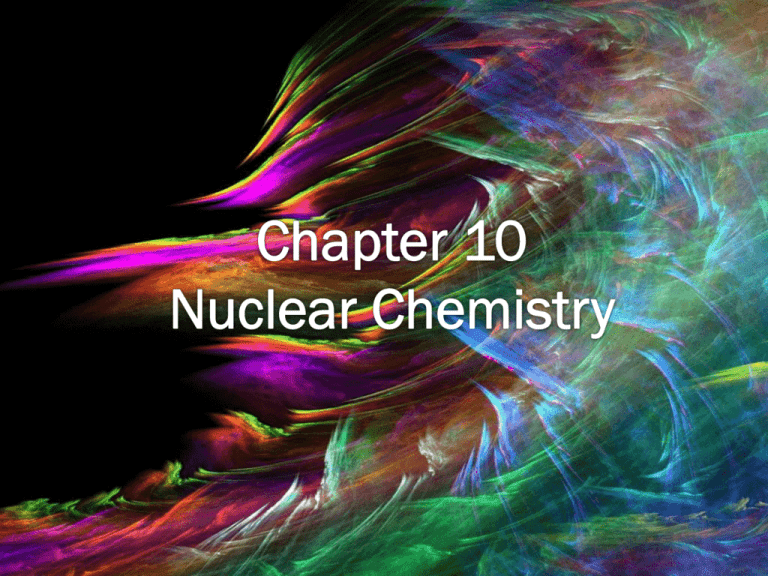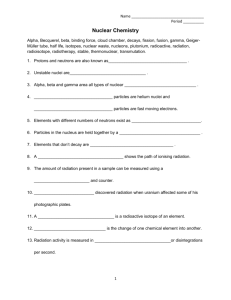an unstable atomic nucleus emits charged particles and energy.
advertisement

RADIOACTIVITY Ò Radioactivity is the process in which an unstable atomic nucleus emits charged particles and energy. Ò Any atom containing an unstable nucleus is called a radioactive isotope, or radioisotope for short. Ò Uranium-238 is an example of a radioisotope. RADIOISOTOPES Ò Unlike stable isotopes, radioisotopes spontaneously change into other isotopes over time. Ò When this happens, it is called nuclear decay Ò During nuclear decay, atoms of one element can change into atoms of a different element altogether. TYPES OF NUCLEAR RADIATION Ò Nuclear radiation is charged particles and energy that are emitted from the nuclei of radioisotopes. Ò Common types of nuclear radiation include alpha particles, beta particles, and gamma rays. ALPHA DECAY Ò Some samples of radioisotopes emit alpha particles. Ò Example: Uranium-238 Ò An alpha particle is a positively charged particle made up of two protons and two neutrons. Symbols for alpha particles 4 2 He BETA DECAY Ò Some samples of radioisotopes release negatively charged radiation called beta particles Ò A beta particle is an electron emitted by an unstable nucleus. Symbols for beta particles 0 -1 e GAMMA DECAY Ò Not all nuclear radiation consists of charged particles. Ò A gamma ray is a penetrating ray of energy emitted by an unstable nucleus. Ò Gamma radiation has no mass and no charge. Symbol for gamma radiation EFFECTS OF NUCLEAR RADIATION Ò You are exposed to nuclear radiation every day, most of this being background radiation, which occurs naturally in the environment. Ò The radioisotopes in air, rocks, water, plants and animals contribute to background radiation. Ò BR levels are generally low enough to be safe. The mineral autunite is an Important source of uranium. Cosmic rays are streams of electrically charged particles. Collisions between cosmic rays And Earth’s atmosphere shower the surface below with nuclear radiation. EFFECTS CONT’D Ò When nuclear radiation exceeds background levels, it can damage the cells and tissues of your body. Ò Nuclear radiation can ionize atoms making your cells no longer function properly. DETECTING NUCLEAR RADIATION Ò Scientific instruments can detect nuclear radiation since you cant see, hear, or feel the radioactivity around you. Ò Devices that are used to detect nuclear radiation include Geiger counters and film badges. GEIGER COUNTERS Ò The greater the amount of nuclear radiation, the greater the electric current produced in the gas filled tube attached to the Geiger counter. FILM BADGES Ò People who work with radioactive materials wear film badges to monitor their exposure to nuclear radiation. Ò The exposure on the film indicates the amount of radiation exposure for the person wearing the badge. HALF-LIFE Ò Every radioisotope decays at a specific rate that can be expressed as a half-life. Ò A half-life is the time required for one-half of a sample of a radioisotope to decay. Ò After one half-life, half the atoms in a radioactive sample have decayed, while the other half remain unchanged. Ò After two half-lives, half of the remaining half decays, etc.









